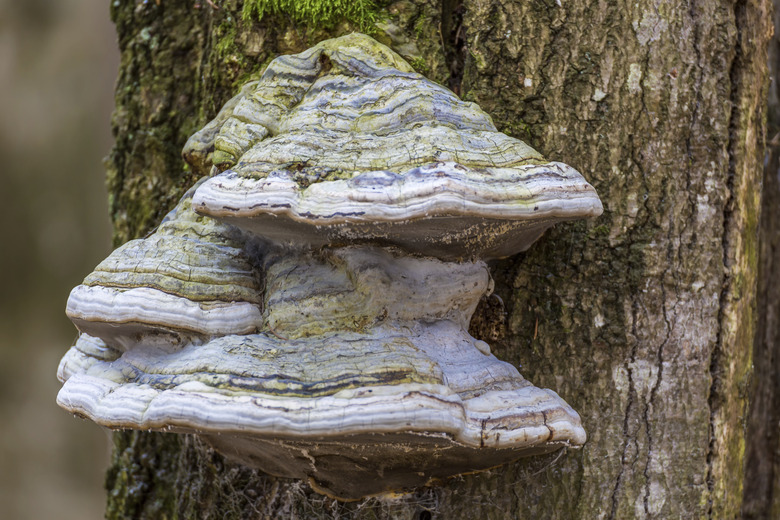Antifungal For Plants
Fungi are tiny organisms that, like bacteria, live in the soil and contribute to the decomposition of dead plant materials. Because they cannot manufacture their own food, they also feast on healthy roots, stems and leaves, creating conditions that can be fatal to flower and vegetable plants. You can minimize the likelihood of fungal diseases in your plants by combining proper care and maintenance with a few preventive measures that include applying antifungal treatments when necessary.
Fungal Disease Facts
Plants contract fungal diseases from the soil, air and water, and sometimes via insects, viruses and harmful bacteria that leave plants depleted and weakened. Plants suffering from damping-off disease fall over before they've become fully established, and powdery mildew does its damage above the soil by attacking stems, leaves, flowers and fruit. Another type of fungus called root rot works below ground by attacking the plant's roots. Root rot often doesn't manifest itself until the plant is severely compromised, while mildews and other leaf and stem diseases produce symptoms that are often visible in time to save the plant. If applied as soon as possible after symptoms first appear, most antifungal preparations are capable of halting the disease's progression and preventing it from recurring.
Signs and Symptoms
Powdery mildew appears as a white fluffy growth on leaves and stems and can involve flowers and fruit as well. Root rot disease causes wilting and premature death in plants that, in many cases, showed no other signs of distress above ground. When the plant is pulled from the soil, its roots often appear black, mushy and decayed. Fungal disease also manifests itself as brown or black spots; deformed, yellowed or shrivelled leaves; or wilting of the entire plant. Blossom-end rot in plants such as tomatoes (Solanum lycopersicum) appears as sunken black spots surrounded by white mold on the fruit where it was connected to the flower. Tomatoes (Solanum lycopersicum) can be grown in U.S. Department of Agriculture plant hardiness zones 3 through 9 after the soil has warmed to at least 60 degrees Fahrenheit and are susceptible to root rot as well as blossom-end rot. Verticillium and fusarium wilts present themselves as yellowed curled leaves and wilting of entire plants.
Commercial Products
Antifungal remedies for plants include commercial products that kill the offending organism and create an environment that discourages future infections. Most products work on all types of fungal diseases, with the exception of some types of root rot. The Colorado State University Extension's website states that in order to make a definitive root rot diagnosis and select the correct antifungal, plant root tissues must be examined under a microscope. Most commercial products must be mixed with water before use and are applied to the entire plant ideally on a dry windless day. Organic fungicides include pure copper and wettable sulfur, and are best applied as a spray. Use 1/2 to 2 tablespoons of copper or 1/2 to 1 tablespoon of sulfur for each gallon of water, and saturate the leaves and stems completely. Captan, a commercial product, is mixed according to a ratio of 3/4 to 1 1/2 tablespoons to 1 gallon of water, and Dithane calls for 2 teaspoons for every gallon of water. Apply fungicides at the first sign of problems and every seven to 14 days thereafter until all sign of disease is gone.
Homemade Remedies
You can also make your own cures with products you have around the house, which include spraying both sides of leaves in a solution made by dissolving two 325-milligram aspirins in a quart of water. This solution works well for powdery mildew, black spot and rust. You can also spray leaves with a tea made from 1/4 cup of chamomile blossoms, found in most health food stores in 2 cups of boiling water or 16 tea bags steeped in 2 quarts of water. Let the solution steep until it has cooled and then strain and place in a spray bottle. This solution keeps for approximately one week and works well sprayed on the soil to prevent damping off. Other homemade remedies include spraying the tops and bottoms of affected leaves with a solution of 1 tablespoon baking soda, 1/2 teaspoon of mild dish detergent and 2 1/2 tablespoons vegetable oil in 1 gallon of water, and apply it every four to five days. This solution works well as a general fungicide. Shake well before using. Spray both sides of affected leaves once a week during dry weather and twice in wet weather with undiluted hydrogen peroxide. Test a small piece of plant tissue for an unwanted reaction before applying. Spray these mixtures early in the morning or in the evening when conditions are not sunny and hot.
Preventive Practices
Healthy plants are better able to resist fungal diseases. This means planting seeds at the right time when the soil is sufficiently warm for optimum germination and setting plants out when the soil is not too wet, as many plant fungal diseases are caused and spread by excess moisture in the soil and on the plants. Provide loose rich soil that drains properly, limit the ability of the fungus to breed by allowing the soil to dry out between rain events or hand watering, and water only when it's necessary. Also, avoid working in the garden when plants are wet, as this also facilitates the spread of fungal diseases.
